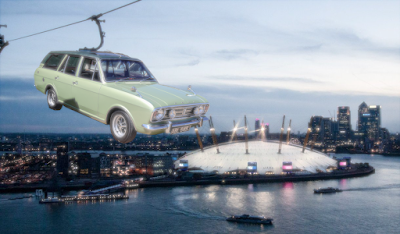The high road to Woolwich: White-knuckle terror and vehicular stress-testing at 260ft
Cross-posted to r/ImaginaryLondon
East of Tower Bridge, as the meandering Thames widens its course, the river crossings diminish to tunnels, segregated for foot, rail and road traffic, while, on the surface, a few scattered ferries ply the waters back and forth between the north and south banks.
From 1973 to 1987, a precarious third option existed for anyone brave enough to take to the air: The Tramblecar ruled, if not the entirety of the skies over London, then a narrow diagonal cross-section, stretching between Silverton and Woolwich. It was, as the name suggests, a cable car, albeit one that transported vehicles. Initially this entailed paying a sum of £47 for a linking apparatus to be permanently mounted onto the roof of your car, that would allow it to be hooked up to the cable.
Connecting to the line was a three stage process: Cars would first roll onto a pivoting weigh bridge that was used to determine not only the tonnage of the vehicle but also the distribution of the weight. If the car passed this test the operator of the bridge would hand the driver a form consisting of a long table of calculations. One entry would be circled, indicating to the 'hook man' the adjustments that needed to be made to the mounting to ensure a relatively horizontal transit across the river.
Once the hook had been connected it would flex five times to assess whether the framework of vehicle was structurally sound enough to remain intact during its journey.
In 1982, following a few near misses in which this system partly failed, leaving cars dangling almost vertically, pointing either down or up like hooked sardines, the roof mount system was abolished. Instead cars were driven into metal cages that were permanently attached to the cable.
David Vint was an early adopter and weekday user of the Tramblecar:
“We had a green Ford Cortina estate,” recalls his son, Joseph. “One morning, as I was setting off on my paper round, my dad was out in our front driveway taking off the roof rack. He returned home from work that evening, far earlier than normal, with a big smile on his face. We were all ushered outside. He'd draped a tarpaulin over the car and I remember my mum saying: 'What have you done now?” He pulled it off and there was this framework bolted onto the roof. He explained what it was for and claimed that it would cut a total of an hour and a half off his daily commute to work, which he could spend with the family, or, if he wasn't required at home, with his mates down the pub. My mum blew a gasket when he told her how much it had cost.
“The heavy bolts that were used to attach the cable mount went through the roof and into a pair of metal blocks above the back seat. Me and my brother were constantly banging our heads against them. One time, we were going round a roundabout and I bashed my temple against the bolt housing so hard that I bled everywhere. After that my dad padded them with an old eiderdown that he thought my mum didn't want anymore.
“I remember the first time my dad took me on the Tramblecar. When they did the stress test the entire car let out a suppressed groan. It made an even worse noise when it was lifted off the ground, which my dad insisted was normal. I was waiting for the supports around the windows to ping one by one. It didn't help that, after we crossed the weigh bridge, I got out out the back and sat in the front passenger seat, which threw off all the weight calculations, so we were pitched forward, almost at a 45 degree angle. It was like when you're on a roller-coaster, the moment before you make a steep drop. It was terrifying, but when we touched down at the other end, the wave of relief that washed over me was exhilarating. I wanted to do it again immediately. It wasn't nearly as much fun when they started putting the cars in cages.”
Following the initial success of the Tramblecar, that saw the design piloted (mostly unsuccessfully) in other nations, public demand tailed off amidst concerns over safety. In 1986, a twist in the cable resulted in 23 cars being left suspended in their cages over the Thames for 36 hours while the line was painstakingly fed through the mechanism a half-inch at a time until it unkinked. Despite its notoriety, the only death on the Tramblecar occurred when a driver suffered a heart attack at the wheel, during an otherwise uneventful crossing.
After the line closed in 1987, it was was dismantled and sold to a the owner of a north Yorkshire theme park who erected it around the perimeter. It remains in sporadic operation to this day although the land it occupies has been sold and is now a private estate.
~ Sam Redlark




Comments
Post a Comment